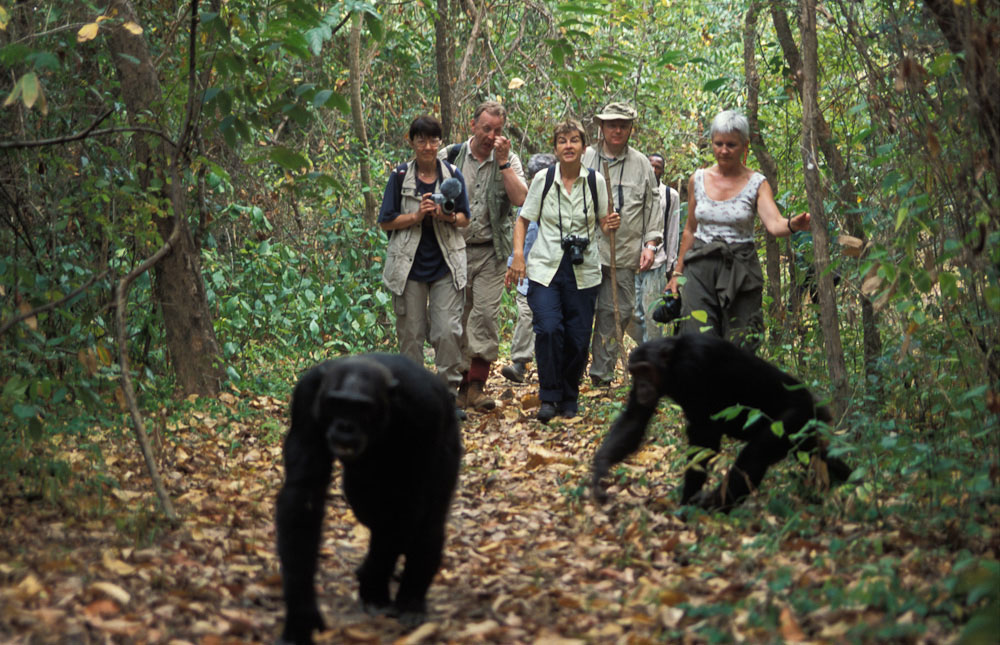 About Mahale Mountains National Park
About Mahale Mountains National Park
In Mahale, the chimpanzees are the star attraction. There are roughly 800 chimps in the park, of which about 60 individuals are very habituated to people. The research and habituation in Mahale is a Japanese project that goes back as long as Jane Goodall’s research in neighboring Gombe NP.
Size: 1613 km² / 623 mi²
Altitude: 757-2474 m / 2484-8117 ft

Set deep in the heart of the African interior, inaccessible by road and only 100km (60 miles) south of where Stanley uttered that immortal greeting “Doctor Livingstone, I presume”, is a scene reminiscent of an Indian Ocean island beach idyll. Silky white coves hem in the azure waters of Lake Tanganyika, overshadowed by a chain of wild, jungle-draped peaks towering almost 2km above the shore: the remote and mysterious Mahale Mountains.
Mahale Mountains is home to some of Africa’s last remaining wild chimpanzees: a population of roughly 800 (only 60 individuals forming what is known as “M group”), habituated to human visitors by a Japanese research project founded in the 1960s. Tracking the chimps of Mahale is a magical experience. The guide’s eyes pick out last night’s nests – shadowy clumps high in a gallery of trees crowding the sky. Scraps of half-eaten fruit and fresh dung become valuable clues, leading deeper into the forest. Butterflies flit in the dappled sunlight. Then suddenly you are in their midst: preening each others glossy coats in concentrated huddles, squabbling noisily, or bounding into the trees to swing effortlessly between the vines. The area is also known as Nkungwe, after the park’s largest mountain, held sacred by the local Tongwe people, and at 2,460 meters (8,069 ft) the highest of the six prominent points that make up the Mahale Range.

And while chimpanzees are the star attraction, the slopes support a diverse forest fauna, including readily observed troops of red colobus, red-tailed and blue monkeys, and a kaleidoscopic array of colorful forest birds. You can trace the Tongwe people’s ancient pilgrimage to the mountain spirits, hiking through the mountain rain-forest belt – home to an endemic race of Angola colobus monkey – to high grassy ridges chequered with alpine bamboo. Then bathe in the impossibly clear waters of the world’s longest, second-deepest and least-polluted freshwater lake – harboring an estimated 1,000 fish species – before returning as you came, by boat.

Tourist attractions
The Chimpanzees
Chain of Mountains (Mahale range)
Forest fauna and flora (Angola colobus, red colobus, red-tailed and blue monkeys, forest birds, alpine bamboo, Montain rain forest etc).
Beach along Lake Tanganyika
Local fishermen. Sun set on the Lake horizon
Pros and Cons
A chance to come face to face with chimps, one of Africa’s big apes
The park is much bigger than Gombe; the more famous chimp park
Pristine forest at the shore of Lake Tanganyika
Watching wildlife on a hike is a nice change from vehicle safaris
Very exclusive and doesn’t get crowded
Wildlife
Mahale’s chimps are the main attraction, but the park supports a diverse forest fauna, including readily observed troops of red colobus, red-tailed and blue monkeys, and many colorful forest birds.
Scenery
The park is a chain of wild, jungle-draped peaks towering almost 2km above the shore of the azure water of Lake Tanganyika. The lake is fringed by white sandy beaches.









